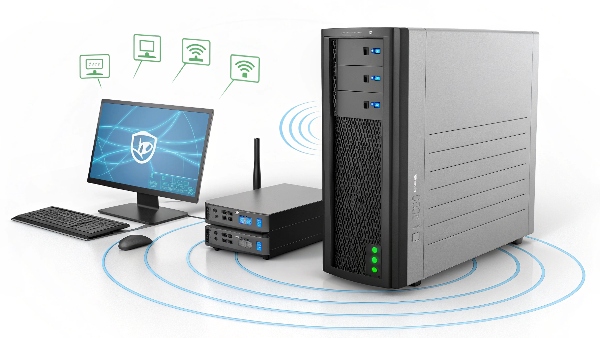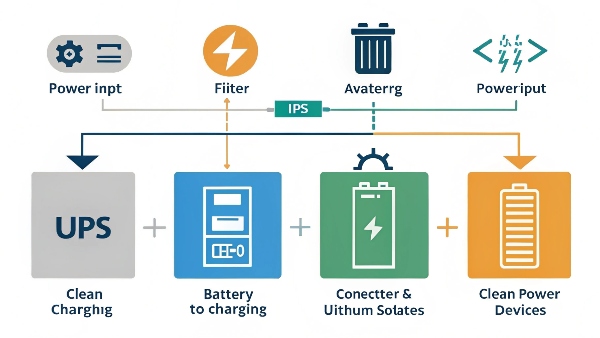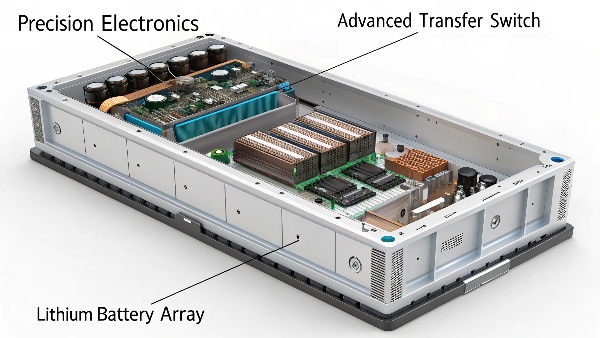Your computer suddenly shuts down during a power outage, losing hours of unsaved work. Critical hospital equipment goes offline during surgery. A data center crashes, costing thousands in lost revenue.
A UPS continuously monitors power quality, provides instant battery backup during outages, and delivers clean, stable electricity to connected devices. It acts as a protective buffer between your equipment and power problems.

Understanding how UPS systems work helps you choose the right protection for your needs. Let's examine the technology behind these essential power guardians.
How Does a UPS Power Supply Work?
Power problems come in many forms - blackouts1, brownouts2, surges, and spikes. Each requires a different protection approach.
UPS systems work through three main stages: power conditioning, battery backup, and automatic voltage regulation. Our lithium battery models add extended runtime and faster recharge capabilities to this process.

Detailed Working Mechanism
-
Power Input Stage
- Receives AC power from wall outlet
- Converts some power to DC for battery charging
- Monitors incoming voltage quality constantly
-
Power Conditioning
- Filters out electrical noise and interference
- Stabilizes voltage fluctuations
- Corrects both under-voltage and over-voltage
-
Battery Backup System
- Instant switch to battery power during outages
- Pure sine wave output for sensitive electronics
- Our lithium batteries provide 50% more cycles than lead-acid
How UPS Works in Home?
Home electronics have never been more sophisticated - or more vulnerable to power problems. Modern households need professional-grade protection.
Home UPS systems guard against data loss, equipment damage, and security system failures. Typical configurations protect computers, networking gear, smart home devices, and critical appliances with 5-30 minutes of backup time.

Home Protection Solutions
| Application | Protection Need | Recommended UPS Type |
|---|---|---|
| Home Office | Computer data protection | Line-interactive 500-1000VA |
| Network Equipment | Maintain internet connection | Standby 300-500VA |
| Entertainment System | Protect AV equipment | Line-interactive 800-1500VA |
| Medical Devices | Life support equipment | Double-conversion 1500VA+ |
| Whole Home | Essential circuits | Standby 3000VA+ with EBM |
Our residential lithium UPS models offer quieter operation and longer lifespan than traditional systems.
How Exactly Does UPS Work?
The technical details determine whether your UPS provides adequate protection or just false security.
Precision electronics continuously analyze incoming power, while sophisticated circuitry maintains perfect output conditions. When problems occur, our advanced transfer switches react in 2-8 milliseconds - faster than any electronic equipment can notice.

Core UPS Technologies Compared
-
Standby UPS
- Basic surge protection normally
- Switches to battery only during outages
- Typical transfer time: 5-10ms
- Best for: Basic computer protection
-
Line-Interactive UPS
- Active voltage regulation always on
- Handles brownouts without using battery
- Transfer time: 2-4ms
- Best for: Business and prosumer use
-
Double-Conversion UPS
- Complete power reconstruction
- Equipment always runs on clean UPS power
- Zero transfer time
- Best for: Mission-critical applications
How Long Can UPS Last Without Power?
Runtime determines whether your UPS is a band-aid or real insurance against power failures.
Standard UPS units provide 5-30 minutes at full load, while extended runtime models with external batteries offer 2-8 hours. Our lithium battery solutions reach 12+ hours runtime with proper configuration, outperforming lead-acid alternatives.

Runtime Comparison: Lithium vs Lead-Acid
| Factor | Lithium UPS | Traditional UPS |
|---|---|---|
| Normal Runtime | 30-90 minutes | 5-30 minutes |
| With EBM | Up to 12 hours | Up to 4 hours |
| Recharge Time | 2-3 hours | 6-8 hours |
| Temperature Range | -20°C to 60°C | 0°C to 40°C |
| Cycle Life | 3000+ cycles | 300-500 cycles |
| Weight | 50% lighter | Heavy |
Our engineers can design custom UPS solutions with exactly the runtime your application requires, from minutes to days.
Conclusion
A modern UPS isn't just a battery backup - it's an intelligent power guardian. From nanoseconds-fast surge protection to extended lithium battery runtime, today's UPS systems offer tailored solutions for every need, from home offices to hospital ICUs to global data centers.

